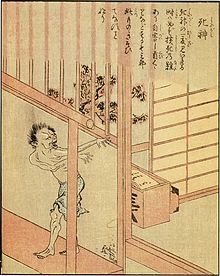Shinigami
From Wikipedia, the free encyclopedia
Shinigami (死神?, "god of death" or "death spirit") are gods or supernatural spirits
that invite humans toward death, and can be seen to be present or
interpreted to be present in certain aspects of Japanese religion and
culture.
Contents
Japanese religion
"Depiction of Searching in the Blue Sea by Amanonu (天瓊を以て滄海を探るの図)" by Eitaku Kobayashi. Izanami is to the left.
However, Izanami and Yama are also thought to be different from the death gods in western mythology.[3][6] Some forms of Buddhism do not involve believing in any deities, so it is sometimes thought that the concept of a death god does not exist to begin with.[3] Even though the kijin and onryō of Japanese Buddhist faith have taken humans' lives, there is the opinion that there is no "death god" that merely leads people into the world of the dead.[6]
Ningyō jōruri
Generally the word "shinigami" does not appear to be used in Japanese classical literature, and there are not many writings about them,[7] but going into the Edo period, the word "shinigami" can be seen in Chikamatsu Monzaemon's works of ningyō jōruri and classical literature that had themes on double suicides.In Hōei 3 (1706), in a performance of the "Shinchuu Nimai Soushi," concerning men and women who were invited towards death, it was written "the road the god of death leads towards,"[8] and in Hōei 6 (1709), in "Shinchuuha ha Koori no Sakujitsu," a woman who was about to commit double suicide with a man said, "the fleetingness of a life lured by a god of death."[9] It never became clear whether the man and woman came to commit double suicide due to the existence of a shinigami, or if a shinigami was given as an example for their situation of double suicide,[4] and there are also interpretations that the word "shinigami" is an expression for the fleetingness of life.[10]
Other than that, in Kyōhō 5 (1720), in a performance of The Love Suicides at Amijima, there was the expression, "of one possessed by a god of death." Since the character was seller of paper, the character who confronted death wrote "paper" (紙, kami) as "god" (神, kami),[11][12] but there are also interpretations that Chikamatsu himself didn't think about the existence of a shinigami.[4]
Classical literature
"Shinigami" from the Ehon Hyaku Monogatari. By Shunsensai Takehara.
In the later Edo Period, the essay "Shōzan Chomon Kishū" in Kaei 3 (1850) by the essayist Miyoshi Shōzan, the one titled "upon possession by a shinigami, it becomes difficult to speak, or easier to tell lies" was a story where a prostitute possessed by a shinigami invites a man to commit double suicide,[15][16] and in the kabuki Mekuranagaya Umega Kagatobi by Kawatake Mokuami in Meiji 19 (1886), a shinigami enters into people's thoughts, making them think about bad things they have done and want to die.[17] These are, rather than gods, more like yūki (meaning ghosts and yūrei[18]), or evil spirits.[4]
In the San-yūtei Enchō of classical rakugo, there was a programme titled "Shinigami," but this was something that was not thought of independently in Japan, but rather from adaptions of the Italian opera the Crispino e la comare[19] and the Grimm Fairy Tale "Godfather Death."[20]
Folk religion
Shinigami are also spoken about in folk religion after the war. According to the mores of Miyajima, Kumamoto Prefecture, those who go out and return to attend to someone through the night must drink tea or eat a bowl of rice before sleeping, and it is said that a shinigami would visit if this was ignored.[21]In the Hamamatsu area, Shizuoka Prefecture, a shinigami would possess people and lead them to mountains, seas, and railroads where people have died. In those places, the dead would have a "death turn" (shiniban), and as long as there is nobody to die there next, they shall never ascend even if they were given a service, and it was said that people who were alive would be invited by the dead to come next.[15] Also, it is ordinary to visit graves for the sake of Higan during noon or when the sun sets, but in the Okayama Prefecture, but visiting the grave for Higan during sunrise would result in being possessed by a shinigami. Also, once one has visited the grave in sunset, it would be necessary to visit the grave also during sunrise, and doing only one would result in being possessed by a shinigami.[15] With this background of folk belief, it is also thought that sometimes people would consider the ghosts of the deceased, who have nobody to deify them, to be seeking companions and inviting people to join them.[15]
In modern culture
After the war, the western notion of a death god entered Japan, and shinigami started to become mentioned as an existence with a human nature,[3] and is a subject in many works of fiction. As the first, in the Shōwa period, it is known that Shinigami appears in the manga work GeGeGe no Kitarou by Shigeru Mizuki, and in the 1979 television drama, "Nippon Meisaku Kaidan Gekijou," the kabuki actor Ganjirō Nakamura performed as a Shinigami.from wikipedia



Tiada ulasan:
Catat Ulasan